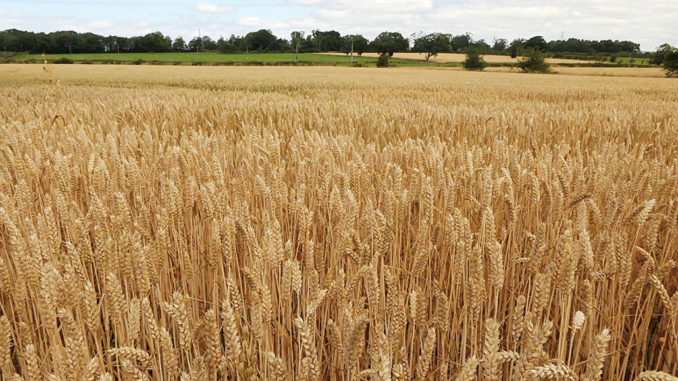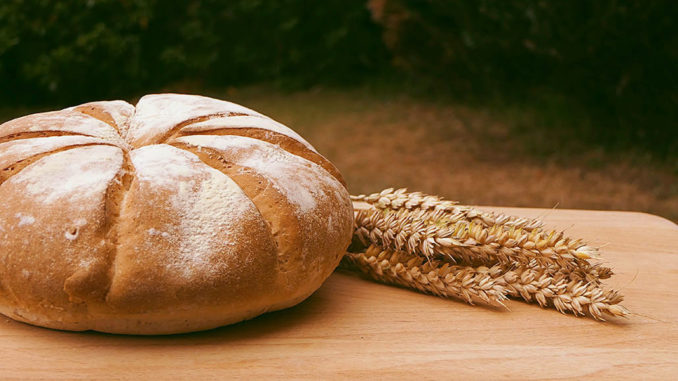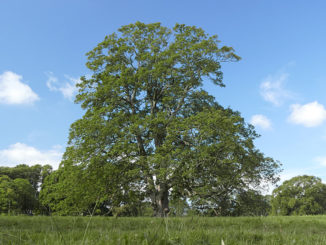
© DMG 2021
Lughnasadh
For me, this was always one of the festivals which seemed to slip under the radar. Which is a shame, because it’s a nice social time, with fun and games, and good food. Falling between the summer solstice and the autumnal equinox, it is one of the four main sabbats of the Celtic year, so I’m surprised it passed me by for so long.
At its simplest, Lughnasadh is a Gaelic festival marking the beginning of the harvest season. It is a celebration of ‘first fruits’ and is a time of joy. For many in the Irish community especially, August has become a traditional time to arrange family reunions.
However, this is tainted with the sun hanging noticeably lower in the sky, giving rise to a foreboding sense that winter and darkness is drawing nearer, and there is tension in the air with the knowledge that the annual struggle to complete the harvest in time has commenced.
While Lughnasadh was chiefly celebrated in Ireland and Scotland, it was also marked in Wales, Cornwall, on the Isle of Man, and the Anglo-Saxons had their own versions. Celebrating the gifts of nature is a natural festival for any agricultural society, but in a break with tradition, bonfires didn’t feature much in Lughnasadh celebrations. And while I suspect it is a more recent addition, visiting holy wells and making offerings has become popular.
There is a lot of ritual importance and customs associated with cutting the grain, which as you might expect vary from region to region. Cutting the first sheaf was often done ceremoniously at dawn. It would be ground and baked into the harvest bread for the community to share, while the first barley to be harvested would immediately begin its transformation into the first beer of the season. The cutting of the last sheaf was also a ceremonial affair, and it was commonly made into a corn dolly, and taken to the village to feature at a harvest supper.
After Beltane, Lughnasadh is the most popular time of the year for handfasting rituals, and at Teltown in Ireland, trial marriages were conducted. This custom involved couples joining hands through a hole in a door, and as was common, the wedding would last a year and a day, after which, they were free to choose to make their marriage permanent, or part ways without any recriminations.
It is said that Lughnasadh is held on the first day of August (technically, beginning on August eve), but in relatively recent times it is often celebrated on whichever Sunday is nearest. With harvest being a crucial time, downing tools for a party was a risky prospect especially if the weather was about to take a turn for the worse. It makes sense to celebrate on Sunday — the day of rest — when no farming would be done anyway. It’s also quite possible the date has been affected by the change to the Gregorian calendar, so the traditional ‘about halfway between the summer solstice and the autumnal equinox’ strikes me as the simplest and most honest guidance with regards to when it should be held. The Celts also seemed keen on marking these occasions when it was a full moon, so there is clearly quite a bit of latitude allowed.

© DMG 2021
So where does Lughnasadh come from? In Old Irish the name was Lùgnasad, which is a combination of ‘Lug’ meaning the god Lugh, and ‘násad’, referring to an assembly. There is quite a variety in spellings, and it is commonly written as Lughnasadh or Lughnasa. In Modern Irish, ‘Lúnasa’ is also the name for the month of August, and in modern Scottish Gaelic both the festival and the month are called either Lùnasda (pronounced Loon-usd-a) or Lùnasdal. I don’t think my Gaelic dictionary has ever seen as much use before researching this article…
The Welsh take their name for the day from Latin, calling it Calan Awst, which translates to the Calends of August.
Another term for the day comes from the old Anglo-Saxon ‘hlaef-mass’, or ‘loaf mass’. This is where the first loaf of bread would be consecrated. This evolved into Lammas, used by the later medieval English and Scots. It is first mentioned in Anglo-Saxon chronicles in 921 AD and is referred to as a ‘feast of the first fruits’. This is portrayed today as a Christian holy day, though I have no doubt that it has supplanted an older, pre-Christian celebration. And while pop culture references are hardly authoritative, Lammas was portrayed as a Satanic day in an Inspector Morse episode, as well as being referenced in the soundtrack to the film The Wicker Man, suggesting there is more to it than pure, wholesome Christianity.
So, who was this god, Lugh? His name is sometimes written as Lug (the modern spelling is Lú) and depending on which sources you read, he is either the son or adopted son of the Queen Tailtiu. She is said to have died of exhaustion after clearing the forested plains of Ireland for agriculture.
“Long was the sorrow, long the weariness of Tailtiu, in sickness after heavy toil; the men of the island of Erin to whom she was in bondage came to receive her last behest. She told them in her sickness (feeble she was but not speechless) that they should hold funeral games to lament her – zealous the deed”
Lugh accordingly announced a funeral feast in her honour, accompanied by an athletic competition, which became an annual event. These games were called the Óenach Tailten or Áenach Tailten, and it is said that Tailtiu inspired the name of the settlement Teltown (in modern-day County Meath) where they were held. According to medieval writings, kings attended this óenach, and a truce was called for its duration. It really was the Olympic Games of its day.
At its core were athletic and sporting contests, but in ancient times it was also the traditional time to settle legal disputes, arrange marriages, and hire workers for the coming harvest. Accompanying all of this were craftsmen, musicians, and storytellers all showing off their latest creations. Horse races are also a key part of the celebrations, though the practical aspect of this may have been for traders to assess the fitness and ability of the horses on offer.
The Victorians decided to label Lugh as sun god (mistakenly, according to just about everybody else), when in fact he is famed for being gifted with a vast number of skills, including sharp wits. He is respected for his communicative skills, as well as his ability to pass boundaries and gates, and so it is easy to see why the Romans also equated him with Mercury. He is also considered to have an affinity with storms and lightning, with stormy weather around Lughnasadh seen as a good omen. I’m no expert in weather patterns around this time of year, but I wonder if storms around Lughnasadh provides hints as to the weather over the coming months?
One tale sees Lugh attempting to gain entry to King Nuada’s court, but entry is denied unless he can show he possesses a useful skill. Lugh lists his many talents to the gatekeeper, including builder, smith, champion, harp player, and so on. He is rebuffed each time, being told that the King already has someone to fill each of those roles. Lugh then asks if the King has a single man who possesses ALL of those skills. He thus gains admittance, wins various challenges set by the other gods, and earns their respect.
When King Nuada is wounded, rule of the kingdom passes to Lugh’s equal but opposite, Bres Mac Elatha. Unfortunately, Bres is a poor ruler, and the period is characterised by famine, blight, and unrest. To add to the misery, Lugh’s grandfather was Balor, a tyrannical ruler and king of the Fomorians, who were a giant, monstrous, deformed people who constantly waged war. Like the cyclops, Balor only had one eye—his ‘evil eye’ — which had the power to bring death. Lugh agreed to lead men into battle, where he faced off against Balor. Being nimble and quick-witted, Lugh kills his opponent by casting a stone from a sling into Balor’s eye.

© DMG 2021
When the dust had settled, the people were ready to execute Bres, but he begged for his life, and was eventually released after agreeing to teach the people how to plough, reap, and sow – guaranteeing them a harvest every year.
So, while Lughnasadh was ostensibly conceived in honour of Lugh’s mother, it is really about the contrast between Lugh and Bres. Folklorist Máire MacNeill distilled the main theme of Lughnasadh as a struggle for the harvest between two gods: with Lugh triumphing over whichever spirit or god is guarding the harvest.
Other versions of the tales see Lugh trying to win over a woman called Eithne, who represents the grain, and one of his tasks is to defeat Balor, who represents blight, drought and the scorching summer sun.
Another version has another god, Crom Dubh, guarding the grain as his treasure, and Lugh has to take it from him on behalf of mankind. In Ireland, aside from Lugh, Crom Dubh is probably the most well-known god associated with the festival, with the last Sunday before Lughnasadh being known as Domhnach Croim Dhuibh, or ‘Crom Dubh’s Sunday’. Crom is often known as Cromm Cruiach, or ‘Crom of the Hill’, matching Lugh’s association with high places. It is said that Lugh and Crom Dubh engage in battle every year, with Crom returning to the underworld after his defeat. Perhaps mimicking this conflict, in the Lothian area of the Scottish Lowlands, in the 18th Century, rival groups would build towers out of sods of earth and plant a flag on top. Each group would attempt to sabotage or demolish the other’s tower, and at Lughnasadh they would meet in mock battle.
Another tale has Crom releasing a bull which Lugh must overcome. I was surprised to discover that that bull sacrifices around Lughnasadh were recorded as late as the 18th Century at Cois Fharraige in Ireland, and Loch Maree in Scotland.
It has been theorised that Crom Dubh may be inspired by another underworld god such as Pluto or Hades, who kidnaps the grain goddess Persephone but is forced to let her return to the world above before harvest time. In later folklore, Lugh is written out altogether in favour of Saint Patrick, while Crom Dubh is given the role of a greedy ‘pagan’ chief who owns a granary or bull. Naturally this version ends with Patrick winning him over and converting him to Christianity.
Another figure important to Lughnasadh is the Goddess in her role as Grain Mother, Harvest Mother, Harvest Queen — or any number of variations of the title. She represents the ripe corn of the current harvest, while her daughter represents the grain, which will lie dormant through the winter, but represents the future new growth.
Corn dollies are common across the world in practically all agricultural societies. Confusingly, they don’t have to be fashioned from corn. That is just the word that meant ‘grain’ in ancient times, though it means something quite specific in our modern language. The word ‘dolly’ itself is said to be slang for ‘idol’, which comes from the Greek word ‘eidolon’, which itself means ‘spirit’ or ‘apparition’.
So, the origin of our corn dolly is likely to be ‘spirit of the grain’. A common belief was that after harvest, these spirits would be homeless, and were brought into the home to protect it until the following spring. Practically every region has its own style and design of corn dolly, but one that appeals to me (I’m not sure where it is most prevalent, as I can only find it described as ‘European’) has a large Corn Mother made, with a small corn baby inside, representing the future.
This shows a fundamental respect for the continuation of life from generation to generation and has a deep and meaningful resonance with regards to motherhood. Consider that a woman pregnant with a daughter isn’t just carrying her own child, but also the potential for her own grandchildren — with her unborn child’s ovaries already carrying all the eggs they will ever release. I think this might be the perfect illustration of the instinctive distrust many people have of genetically modified crops. These interfere with the farmer simply holding back some of his own grain for replanting the following season — the chain of life is broken, and it goes against everything we as a species have relied upon since humans first thought to take control of our environment tens of thousands of years ago. Little wonder many people feel uneasy, with a sense that it is ‘wrong’ somehow, even if they struggle to verbalise why.
Another figure linked to Lughnasadh is ‘John Barleycorn’, sometimes referred to as the living spirit of the grain, and sometimes as the Green Man. Recently, it has been suggested that Lugh is in fact John Barleycorn, but this appears to be another recent medieval ‘development’. As the grain is cut, John Barleycorn is sacrificed so that the community can survive, but at the same time the seeds he leaves behind ensure the next generation. Like the Grain Mother, it all points back to the most basic themes of sacrifice, death, and rebirth. As individuals, we have a time to live and a time to die, but as a people — we can be immortal.
Like his Greek and Roman counterparts, Lugh seems to have been associated with, and worshipped atop hills and mountains, which explains the treks up Ireland’s most prominent peaks. Sometimes flowers would be worn on the way up, which would be buried at the summit to signify the end of summer. Alternatively, the first sheaf of the harvest might be buried. The most popular of these expeditions were rebranded as Christian pilgrimages, with the most well-known being the walk up Croagh Patrick held late in July on Reek Sunday.
Máire McNéill argued that there is evidence for Lughnasadh being celebrated throughout the British Isles, while writer Ronald Hutton has made the case that Tailtiu is a medieval invention and that it was a purely local event at Teltown. Tailtiu has been linked with the Roman goddess Tellus, who is also a ‘Mother Earth’ figure, and it has been suggested that her name is derived from ‘Talantiu’, meaning ‘great one of the Earth’.
It is possible that McNéill and Hutton are both right. It strikes me that despite Lughnasadh appearing very Celtic-centric, the same date and the harvest seemed to have been marked across the country in very similar ways. So while the inauguration of Lughnasadh at Teltown might be specific to the local legends, there are numerous myths and gods associated with the same festival in different places. It is unlikely that Tailtiu is simply a medieval invention, but it also cannot be ruled out that she was a medieval addition to the existing Teltown traditions.
There are plenty other festivals which are believed to be offshoots of Lughnasadh, with one of the most well-known being the Puck Fair, held in County Kerry. Taking place in the town of Killorglin, it has been traced back to the 16th Century. It is a three-day festival in early August, which kicks off with a wild goat being brought into town and being crowned king, and a local girl being crowned queen. There is a market, a horse and cattle fair, music and dancing, and arts and crafts.

© DMG 2021
No doubt seeing the draw of tourists for the Puck fair, other towns in Ireland have started to hold similar Lughnasadh festivals. I don’t really see a problem with this if it helps prevents old traditions from fading away. We have largely drifted away from being an agricultural society, but our food still needs to be grown and reared, so marking the season with a festival which appeals to modern folk can’t be a bad thing.
So how can we celebrate the beginning of the harvest? First and foremost, just have fun. Get together and organise some games. These could be simple physical challenges of the sort we all remember from sports’ days at school, or they could be mental challenges or board games. You could relax by playing instruments and singing songs, or take turns telling stories. And don’t forget to serve up some seasonal produce from the beginning of the harvest, such as freshly baked bread, or hand-picked berries. All in all, the perfect way to enjoy some company while the good weather lasts.
Next up: Mabon!
© Carvetii 2021
The Goodnight Vienna Audio file



